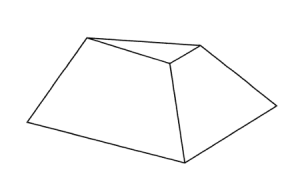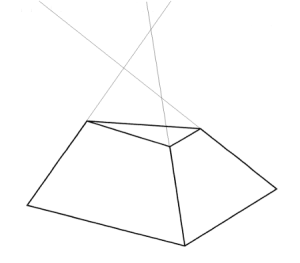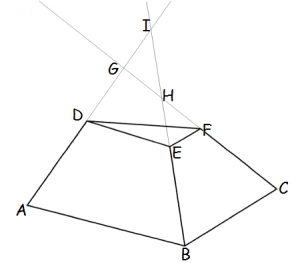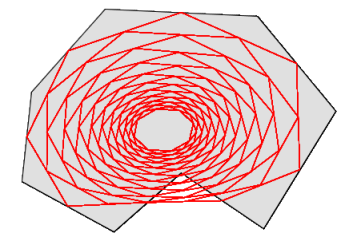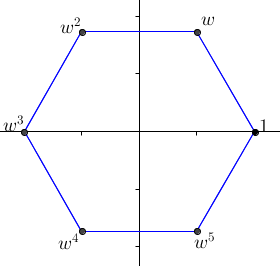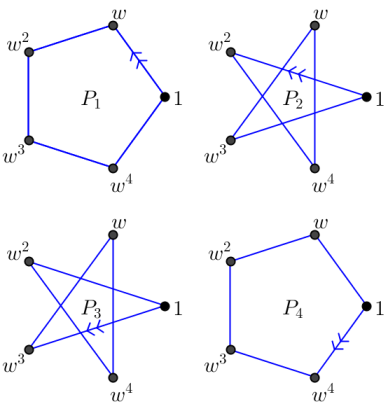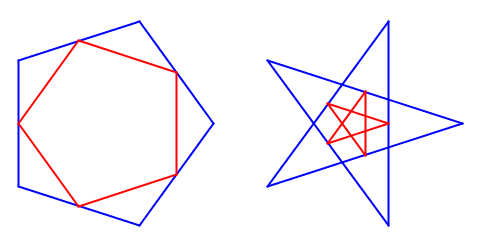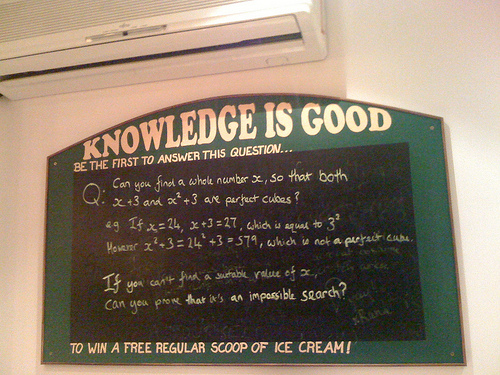A real function is said to be periodic if there exists a real number  so that
so that  for all
for all  . The number
. The number  is said to be a period of the function. The most familiar examples of periodic functions are the trigonometric functions sine, cosine, and tangent.
is said to be a period of the function. The most familiar examples of periodic functions are the trigonometric functions sine, cosine, and tangent.
Note that if  is a period of a function, then
is a period of a function, then  are also periods. If a periodic function is continuous and nonconstant, then it has a least period, and all other periods are positive integer multiples of the least period.
are also periods. If a periodic function is continuous and nonconstant, then it has a least period, and all other periods are positive integer multiples of the least period.
There are discontinuous periodic functions that have no least period. The most famous example is the Dirichlet function, defined by  if
if  is rational,
is rational,  if
if  is irrational. Every positive rational number is a period of the Dirichlet function, so there is no least period.
is irrational. Every positive rational number is a period of the Dirichlet function, so there is no least period.
Sums of periodic functions are often periodic
The sum of two periodic functions is often periodic, but not always. Suppose that  is periodic with least period
is periodic with least period  , and
, and  is periodic with least period
is periodic with least period  . If
. If  and
and  have a common multiple
have a common multiple  , then
, then  is periodic with period
is periodic with period  . However,
. However,  is not necessarily the least period of
is not necessarily the least period of  . To give an extreme example,
. To give an extreme example,  has no least period.
has no least period.
Some readers may have heard of biorhythm theory, which was popular in the 1970s. The theory claims that humans are influenced by three fundamental cycles: a physical cycle of 23 days, an emotional cycle of 28 days, and an intellectual cycle of 33 days. These cycles are usually modeled as sine waves that start on one’s day of birth. We might suppose that a person’s happiness on day x is the sum of these three cycles.


The figure shows a portion of the graph of this function. It appears to be quite irregular but in fact it repeats every 21,252 days, since 21,252 is the least common multiple of 23, 28, and 33. (View this graph on Desmos.)
Sums of periodic functions are not always periodic
If the periods of two periodic functions do not have a common multiple, then their sum is not periodic. Perhaps the simplest example is  , whose terms have least periods 2π and 2 respectively.
, whose terms have least periods 2π and 2 respectively.
Polynomials are finite sums of periodic functions
Sums of periodic functions can be peculiar indeed. In fact, we can prove the following astonishing theorem: If  is a polynomial function of a real variable, and the degree of
is a polynomial function of a real variable, and the degree of  is
is  , then
, then  is the sum of
is the sum of  periodic functions.
periodic functions.
It is clear that a non-constant polynomial cannot be expressed as a finite sum of continuous periodic functions, since a continuous periodic function is bounded, and a finite sum of bounded functions is bounded. In fact, it can be shown that an unbounded continuous function cannot be expressed as a finite sum of Lebesgue measurable periodic functions. Consequently, we will need to use the Axiom of Choice.
R as a vector space over Q
The statement that every vector space has a basis is equivalent to the Axiom of Choice. Since  is a vector space over
is a vector space over  , there is a subset
, there is a subset  of
of  , called a Hamel basis, so that every real number can be written uniquely as a finite linear combination of elements of A with rational coefficients.
, called a Hamel basis, so that every real number can be written uniquely as a finite linear combination of elements of A with rational coefficients.
For each  , we write
, we write  where
where  is rational and
is rational and  is finite for every
is finite for every  .
.
Periodicity of (x,a)
It is readily seen that  for all
for all  and all
and all  . Moreover
. Moreover  for distinct
for distinct  . It follows that
. It follows that  for all
for all  and distinct
and distinct  . In other words, the function
. In other words, the function  is periodic with period
is periodic with period  for any
for any  .
.
The identity function is the sum of two periodic functions
Choose two distinct elements  . Then
. Then  .
.
Let  and
and  .
.
Then  has period d,
has period d,  has period c, and
has period c, and  is the identity function.
is the identity function.
x^2 is the sum of three periodic functions
Note that  . Choose three distinct elements
. Choose three distinct elements  . The term
. The term  has period
has period  , unless
, unless  or
or  . Since no term involves all three of
. Since no term involves all three of  , it follows that each term has a period of either
, it follows that each term has a period of either  ,
,  , or
, or  .
.
Let  be the sum of all terms which have period
be the sum of all terms which have period  ; let
; let  be the sum of all terms which have period
be the sum of all terms which have period  but not
but not  ; and let
; and let  be the sum of all terms which do not have period
be the sum of all terms which do not have period  or
or  . Such terms must have period
. Such terms must have period  . More specifically,
. More specifically,



Then  is a representation of
is a representation of  as the sum of three periodic functions.
as the sum of three periodic functions.
A polynomial of degree n is the sum of n+1 periodic functions
Let P be a polynomial of degree n. Using the identity  we can express P(x) as a linear combination of products
we can express P(x) as a linear combination of products  with
with  . Each term involves at most n distinct elements of A.
. Each term involves at most n distinct elements of A.
Let  be
be  distinct elements of A. No product
distinct elements of A. No product  in the expansion can involve ALL of
in the expansion can involve ALL of  . Therefore, we can group the terms into
. Therefore, we can group the terms into  sums,
sums,  , so that no term in
, so that no term in  involves
involves  .
.
Thus, we have  , and each
, and each  has period
has period  . QED.
. QED.
A polynomial of degree n cannot be written as the sum of n periodic functions
Suppose that for some n, there is a polynomial P of degree n which is the sum of n periodic functions. Let p be one of the periods. Then  is a polynomial of degree
is a polynomial of degree  , and it is also the sum of
, and it is also the sum of  periodic functions, since one of the terms cancels. By repeating this, we eventually obtain a polynomial of degree 1 that is the sum of 1 periodic function. But this is absurd.
periodic functions, since one of the terms cancels. By repeating this, we eventually obtain a polynomial of degree 1 that is the sum of 1 periodic function. But this is absurd.
e^x is not the sum of periodic functions
Suppose that  is the sum of n periodic functions. Let p be one of the periods. Then
is the sum of n periodic functions. Let p be one of the periods. Then  is the sum of
is the sum of  periodic functions, since the term with period p cancels out. But
periodic functions, since the term with period p cancels out. But  is a constant multiple of
is a constant multiple of  , so we conclude that
, so we conclude that  is the sum of
is the sum of  periodic functions. By repeating this, we find that
periodic functions. By repeating this, we find that  is the sum of 1 periodic function. But this is absurd.
is the sum of 1 periodic function. But this is absurd.
Reference
Stefano Mortola and Roberto Peirone, The Sum of Periodic Functions, Topology Atlas Document # vaaa-21
